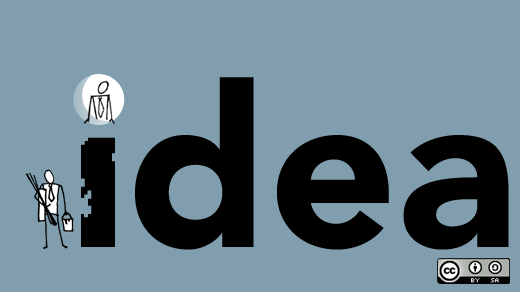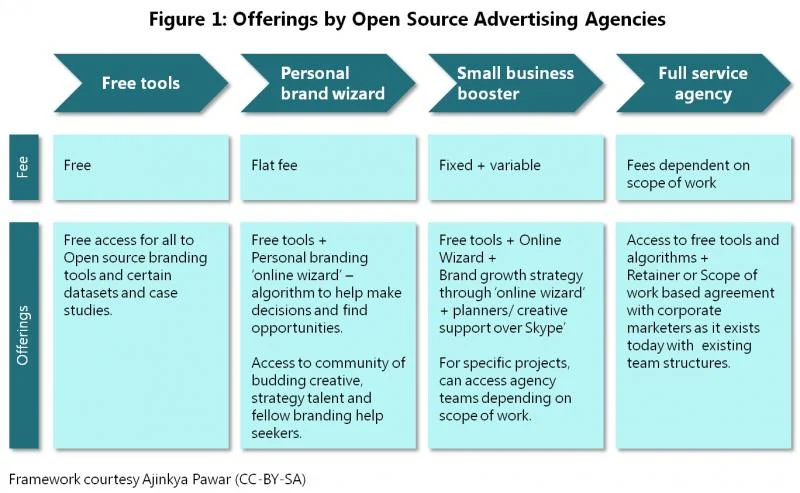In a previous article, I explained why "openness" is a solution the advertising industry should consider when attaining growth. I also explained how we've so far misunderstood the promise of openness.
This article will articulate exactly what it means for agencies to "go open," and what that will entail.
The 'open source' advertising agency
"Open": universally accessible and open to contribution
"Source": the unique logic that solves certain problems.
Understanding a basic perspective on open source is critical. When people talk about "open source" and its relevance to the advertising industry, they might think only about using open source material to create advertising. Or they might talk about projects where users and a brand team co-create something. Some may use the term to describe collaborative cultures, and others might use the term to talk about crowd-sourced plugins to traditional business models.
All of these ideas are united by the smallness of their perspectives.
I'm talking about applying "open source" in a way that could fundamentally inform the advertising business model. So what is it, in this context?
Let's begin by considering the "source code" for advertising agencies: the unique method of approaching a business problem that guides them in finding (what they believe to be) the most effective and creative solution. As contexts and type of business problem changes, so do the methods of developing advertisements for them. Typically, this "source code" is a logical set of questions or framework that guides the application of common sense to the work of solving business problems. They do so by enhancing clarity regarding strategic choices that the marketer has but might be blind to. Identifying the right branding opportunity/ problem is half the battle in effective communications.
These tools are very useful because they prevent creatives from straying away from basic common sense when confronted with too much data. These tools also help with building conviction towards making the right decision, especially when the easier (but possibly ineffective) direction seems more attractive.
These, then, are some of the currently existing "source codes": Ogilvy has its "Big Ideal", "Fusion" and "Do brief." Publicis has "Lead the change." DDB had its "Springboards." Saatchi & Saatchi has its "Lovemarks." And so on.
And I believe this very decision-making process can be subjected to open source thinking.
Open strategy, open creativity
For example, suppose a firm wants to become an open advertising agency. It designs its own "interface" for creative problem-solving, such that people would be encouraged to use, adapt, and improve upon its planning and creative tools. Next, it externalizes the wisdom its employees and its campaigns have acquired through the years, making it available to people who can learn from it and use it to inform their decisions.
For this to work, our firm will have to be cognizant of various requirements, and hence different consumer journeys for three broad bucket of clients. Again, these are:
- Individuals seeking help with personal branding at a flat fee.
- SMEs who need help in growing business with limited budgets and where individuals/ small group of stakeholders take decisions.
- Corporate owned consumer/ enterprise brands with high media spends, where decisions are made by committee/ hierarchies.
To be able to cater to these three different segment at the same time, the agency will require a new business model, new practices, and new expectations of revenue growth. To get a glimpse of that interface, we can learn from pricing strategies of online services and adapt them to the advertising business (see Figure 1).
Figure 1. Click for larger version.
For example, our firm could curate and code tools that make its interface easier to use (not merely accessible)—to all, for free (think of the difference between Google's search interface now and a Yahoo! search and directory from 1996).
For individual users looking to either build a personal brand or test new business ideas, our firm could provide algorithm-based assistance in formulating strategy (programs that take in key data points to choose the right tools/ perspective). Thereafter the focused "brief" at hand can help the person in finding the right ideas with the help of fellow idea seekers and creators in an open forum (look at the interface of Coursera classrooms, for example).
Say a small restauranteur seeks help making her business grow. She can either access free tools and figure out strategy for herself, or pay a flat fee and access the community of people who might help her. Perhaps she can even find a budding creative artist in the community who could help her in designing art works informed with the "brief" she formulated with the help of an algorithm earlier.
If she is ambitious and is seeking rapid growth—and doesn't mind paying the fees for access to our agency's team—then she can do that too.
Changing the model
Shifting to open models would help the advertising industry shift:
- from servicing a few hundred clients at max a year, to catering to potentially a million clients a year.
- from being critically dependent on a few large clients for survival, to a hedged bet with the long tail.
- from an enterprise-oriented orientation to more nimble orientation (something adaptable to serve anybody, from an individual to a fortune 100 company).
- from intimidating jargon to simplified tools that most people can use (simple and obvious always trumps complicated and laborious in advertising—may it be in ads, pitches or everyday work).
- from resource allocation per brand, to additional resources for Skype services and transition teams who would facilitate the transition of a project from online open source to inside the agency (and therefore confidential).
But it would not change:
- the creativity that human insight and human-articulated vision can provide.
- the business dynamic with corporate brands (apart from improvements in universal availability of data and tools).
First-mover advantage
With millions of people using its free tools, the firm stands to create the "default" language and logic of branding strategy for the industry. The first mover in the "open advertising" game stands to set the rules of that game for 21st Century. The first firm to attempt this kind of open approach would see the following benefits.
New repository of consumer insights. The agency will have access to big data stores and metadata about users' businesses, their preferences, and their possible growth trajectories. These data will be useful in building agency intelligence, its effectiveness, and its new business efforts.
Mindshare leadership. The agency will set the language and logic of business growth for a million business leaders of tomorrow.
Virtuous cycle of new business growth. Small businesses and startups would grow with the agency and might stay on as they grow big. Communities of thousands of enthusiasts and free tools users will help establish agency brand credentials. Word of mouth generated by the agency's tools will position it favorably among business leaders.
Attracting good talent. The community would become a channel for budding talent to get noticed. The transparency in helping businesses grow will excite creative talent and attract the best creative talent to the industry again. The widened pool of visible talent and the plurality of projects will help the agency find, train, and mentor the right talent.
Increased marketing literacy among clients and agency personnel. To be frank, many of us in marketing and advertising industry could do with a basic marketing course. Even in 2017, many among us are unsure about digital marketing. Many advertisers could increase efficiency and improve quality of their efforts if they knew about concepts such as "insights," "emotional needs," and "strategic choices" in creative ideas and so on. By "opening up" the culture of advertising thinking, we will help increase marketing literacy and consequently increase confidence in marketing efforts. After all, if clients understand marketing better, they will be more confident about spending money on it.
I am eager to work on this idea and bring it to reality. If anyone finds it interesting, then please let me know with comments below.
(An earlier version of this article originally appeared on Truth about Branding.)







2 Comments